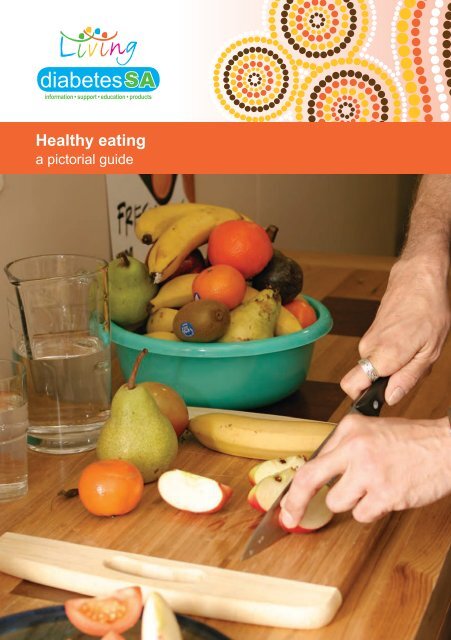atsi-healthy-eating
atsi-healthy-eating
atsi-healthy-eating
You also want an ePaper? Increase the reach of your titles
YUMPU automatically turns print PDFs into web optimized ePapers that Google loves.
This booklet explains <strong>healthy</strong> <strong>eating</strong> and food choices. It is suitablefor all adults and teenagers, including people with diabetes andthose wanting to lose weight. It is intended to be used with advicefrom your dietitian.Diabetes SA is a member based Association. We aim to make apositive difference to the lives of people affected by diabetes.For more information visit www.diabetessa.comThe National Diabetes Services SchemeThe National Diabetes Services Scheme (NDSS) providessubsidised products, information and support services to peoplewith diabetes across Australia. People who are registered withthe NDSS can access a range of free and subsidised productsto assist with their diabetes management including:• Subsidised testing strips for monitoring blood glucose levels• Free insulin syringes and pen needles (for those needing insulinor Exenatide)• Information and support – free diabetes Infoline 1300 136 588• Access to Aboriginal health workers and health professionalsto answer questions on diabetes.We would like Aboriginal and Torres Strait Islander Australiansto register with the NDSS so we can support them better withtheir diabetes.NDSS registration is free and available to all Aboriginal andTorres Strait Islander people who have been diagnosed withdiabetes by a doctor. Talk to your Aboriginal health worker ordoctor for more information about how to register.The printing of this resource was funded through the NationalDiabetes Services Scheme.AcknowledgementThis resource has been developedby Diabetes Australia – Vic.
ContentsHealthy <strong>eating</strong> is important 4Symbols 5Breads and cereals 6 – 7Fruit 8Vegetables 9 – 10Legumes 11Dairy foods 12 – 13Meat and alternatives 14 – 15Fats 16 – 17Drinks 18Alcohol 19Portion control 20 – 21Meals 22 – 27Take-away foods 28 – 29Snacks 30 – 31Daily needs 32 – 33Sample meal plan 34 – 35Healthy cooking methods 36Low cost <strong>healthy</strong> foods 37Diabetes Australia – Vic would like to thank the Aboriginalpeople who appear in this booklet, and acknowledgeSharon Thorpe and Jennifer Browne, Victorian AboriginalCommunity Controlled Health Organisation, for their helpin the production of this booklet.
Healthy <strong>eating</strong> is importantEating <strong>healthy</strong> foods can help to control your blood glucoselevels, cholesterol and blood pressure. It can also help youto achieve a <strong>healthy</strong> weight and waist circumference.To be <strong>healthy</strong>:• Eat a variety of foods fromeach food group• Eat more high fibre foods• Eat less high fat foods• Eat less salt• Eat less sugar• Eat smaller meals• Drink less alcohol• Be more active
SymbolsFat, 1 teaspoon = 5gAdded sugar, 1 teaspoon = 5gFibre = 5gfoods suitable to eat every dayfoods to limit to special occasions5
Breads and cereals6These are low in fibre and/or high in sugar
Breads and cerealsEat at least 4 – 6 serves daily1 serve is:¾ cup cooked rice or pasta2¼ 3 cup cereal (30g)Eat wholegrain and high fibre types more often7
FruitEat 2 serves every day1 serve is:Eat fresh fruits more often8
Dairy foods12These are high in fat
Dairy foodsEat 2 – 3 serves every day1 serve is:200g yoghurt250ml milk2 slices of cheeseEat low fat dairy foods13
Meat and alternatives14These are high in fat
Meat and alternativesmeat, chicken, fish, eggs, tofu, legumesEat 1 – 2 serves dailyEat 3 serves each weekof oily fish includingfresh salmon, mackerel,herring, tinned salmonand sardines1 serve is the palm of your handEat low fat meats/alternatives15
Un<strong>healthy</strong> fats16These fats are not good for your heart,so try to eat less of these
Healthy fatsThese fats are good for your heart, but usein small amounts if you are overweight(no more than 1 tablespoon per day)17
DrinksWater is thebest drinkThese are low in sugarDrinksThese are high in sugar18
AlcoholHave no more than two standard drinks each day, withsome alcohol free days each week.100mlwine285mlbeer60mlport/sherry30mlspiritsThese are all one standard drink19
Portion controlaaEating smaller meals can help to control your bloodglucose levels and can help you to lose weightTry using a smaller plate20
Your plateRice, pasta, starchyvegetables or breadshould take up ¼ ofyour plateNon-starchy vegetablesor salad should takeup ½ of your plateMeat and alternatives shouldtake up ¼ of your plate21
BreakfastThese are high in fat and low in fibre22
BreakfastThese are low in fat and sugar and high in fibre23
Light mealThese are high in fat and low in fibre24
Light mealThese are lower in fat and higher in fibretext.........25
Main mealThese are high in fat and low in fibre26
Main mealThese are lower in fat and higher in fibre27
Take-away foodsThese are very high in fat and sugar and low in fibre28
Take-away foodsThis is a healthier take-away choiceStir-fried chicken and vegetables with 1 cup of cooked rice29
Snack foodsThese are high in fat and/or sugar30
Healthy snacksThese are lower in fat and sugar31
Daily needsBreads and cereals (bread, cereal, rice, pasta, noodles):4 – 6 servesMeat and alternatives: 1 – 2 servesVegetables and salad: 5 or more serves32
Fruit: 2 servesDairy (choose low fat milk, yoghurt or cheese): 2 – 3 serves33
Sample meal planBreakfastMid-morning snack(2-3 hours after breakfast)Lunch(2-3 hours after mid-morning snack)Afternoon snack(2-3 hours after lunch)Dinner(2-3 hours after afternoon snack)Supper(2 hours after dinnerif feeling hungry)34
Sample meal planBreakfastMid-morning snack(2-3 hours after breakfast)Lunch(2-3 hours after mid-morning snack)Afternoon snack(2-3 hours after lunch)Dinner(2-3 hours after afternoon snack)Supper(2 hours after dinnerif feeling hungry)35
Healthy cooking methods36
Low cost <strong>healthy</strong> foods• Shop at markets and greengrocers.Food items are often cheaper around closing times.• Buy fruit and vegetables that are in season.They are often cheaper and taste better.• Serve smaller amounts of meat and add extravegetables or legumes.• Buy generic or home-brand items.• Buy frozen or canned fruit and vegetables.
Notes38
Notes39
Funding for printing this resource was provided by the National DiabetesServices Scheme (NDSS). The National Diabetes Services Scheme is aninitiative of the Australian Government administered by Diabetes Australia.159 Sir Donald Bradman DriveHilton SA 5033t 08 8234 1977f 08 8234 2013Infoline 1300 136 588e info@diabetessa.com.auw www.diabetessa.com.auABN 52 923 028 382© Jun 2014


